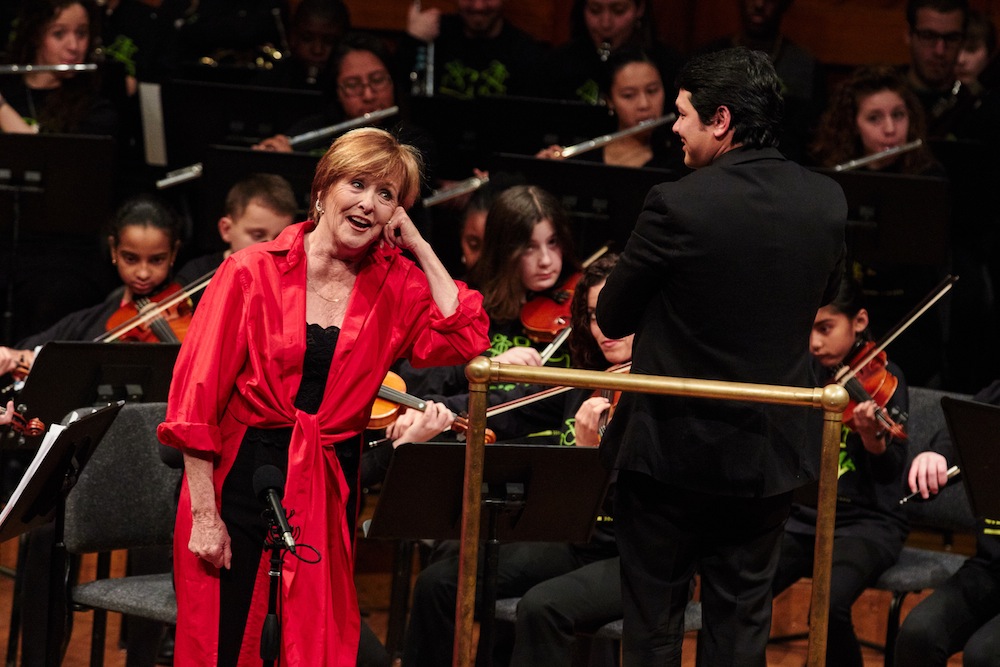Longy’s Side by Side concert offers fresh, light program with von Stade

Frederica von Stade and conductor Jorge Soto at the Longy School’s Side by Side concert Friday night. Photo: Dave Green
In an age when music education programs are being cut left and right in American public schools, it’s a breath of fresh air to see young students engaged in lively music making.
Since its founding in 2013, the Side By Side orchestra, Longy Conservatory’s El Sistema-inspired music program, has paired school-aged musicians from around Massachusetts and Los Angeles with conservatory students for special performances. Friday night at Sanders Theatre, the young members of the ensemble joined mezzo-soprano legend Frederica von Stade for a special concert of popular songs and arrangements of beloved classical works.
El Sistema organizations, community-based initiatives modeled on Venezuela’s music education program, have been popping up all over the country to provide musical opportunities for young students from a variety of economic backgrounds and ethnicities. Longy Conservatory program, in particular, provides enriching experiences for these young musicians through concerts that feature prominent conductors and soloists. The Side By Side orchestra earned press attention last spring when the Los Angeles Philharmonic’s Gustavo Dudamel, the most visible son of El Sistema, conducted an open rehearsal with the students.
Friday night’s concert, conducted by Jorge Soto, featured von Stade in a number of popular songs from the American songbook.
The singer, long known for her work in both opera and musical theatre, sang with a delicate, amber-toned voice and performed with the same captivating stage presence that made her a household name. She was charming in the dreamy love song “A Little bit of Love” from Bernstein’s Wonderful Town, the singer leaning on the rails of the conductor’s podium for effect. von Stade lofted the phrases in “Somewhere” from West Side Story with soft tone, and she made for a chummy Maria von Trapp in “Do Re Mi” from Rodgers and Hammerstein’s The Sound of Music, which also featured a small choir of young singers to depict the Von Trapp children.
Von Stade’s voice has long lost much of its luster, and her singing Friday night suffered from overly generous vibrato and a thin upper range.
But that mattered little as her presence alone seemed to energize the young musicians of the orchestra. Conductor Soto led the ensemble in sturdy performances of the handful of works on the program, and the musicians played with solid intonation that could match many regional orchestras.
The softer passages of the music, though, revealed a few weaknesses in balance, resulting in a sound that was full in the upper and lower registers but often thin in the middle range.
Yet the young musicians’ performance was committed and even colorful, as was the case in the hymn from Sibelius’ Finlandia, heard Friday night. In Manuel Artés’ charming little ditty Chamambo, the Side-by-Side orchestra covered the syncopated pulses from conga drums in a soft blanket of melody.
The most focused playing came in Merle Isaac’s Gypsy Overture, which came alive through the music’s stirring, accelerating pulse.
The most substantial piece on the program was Isaac’s arrangement of the first movement of Dvořák’s Symphony No. 9. Attacks and soli passages, at times, lost the solid ensemble polish heard in the previous works. But there were plenty of strengths. The orchestra’s woodwinds played with focused blend, and the solo flute floated a velvety rendition of the movement’s third theme.
The opener, Brahms’ Hungarian Dance No. 5, arranged by Albert Parlow, was taken at a deliberate tempo for its principal theme. Soto and the orchestra dug in for the inner sections, the music moving seamlessly between stately and quick tempos. The ensemble responded with strong statements, the strings taking on a bright, rosy tone.
Posted in Performances